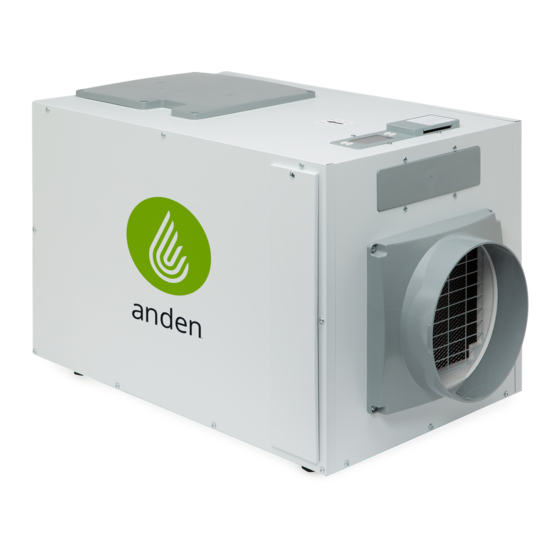Anden A130 Manual de instruções de instalação e funcionamento - Página 10
Procurar online ou descarregar pdf Manual de instruções de instalação e funcionamento para Desumidificador Anden A130. Anden A130 12 páginas.

TROUBLESHOOTING
Technical Support is available Monday through Friday,
7:00 a.m. to 5:00 p.m. CST, at (800) 972-3710. Use the
guides on the following pages to identify and correct system
faults. Contact Technical Support before replacing the unit
or any components and for additional troubleshooting.
TABLE 2 – DIAGNOSTIC CODES
Diagnostic
Code
Failure Mode
E1
Internal Humidity or
Temperature Sensor
Open or Shorted
E2
High Refrigeration
Pressure
E3
Model A77
Remote Control
Communication Loss
E4
Insufficient Capacity
E5
High Temperature
Thermistor Failure
E6
Low Temperature
Thermistor Failure
E7
Float Switch Open
E8
Inlet Air Temperature
Out of 50°F – 104°F
range or dew point
below 40°F
10
When an error occurs, the Diagnostic
Code along with SERVICE REQUIRED
will be displayed on the control screen.
Action
1. Check the connection between the sensor board and control board.
2. If connection okay, replace sensor board, Part No. 5460.
1. Verify that the fan works, the backflow damper swings freely and there is no blocked or restricted ductwork.
2. If the fault persists, call Technical Support.
1. Check connections between Model A77 and dehumidifier control board. Terminals should be fully
inserted and secured in the control board and Model A77 control terminals.
2. If connections are correct and secure, turn off the dehumidifier and remove the Model A77. Use a
short section of 4-wire cable to reconnect the Model A77 to the control board. Turn the dehumidifier
back on and increase the dryness level setting on the Model A77. If the dehumidifier turns on, the
problem is with the wiring between the dehumidifier and control.
3. If the dehumidifier does not turn on, call Technical Support.
1. Check the frost sensor connection at the power board. Terminal should be fully seated on the power
board pins.
2. Remove the side access panel and verify that the sensor is secured to the suction line.
3. If the sensor is connected and secured to the refrigeration line proceed to the next step.
4. Reset the fault by cycling power to the dehumidifier.
5. Turn the humidity setting down (below room/home humidity level) to make a dehumidification call.
6. Allow the fan and compressor to run for approximately 10-15 minutes and then enter diagnostic
test mode by simultaneously pressing the UP ARROW and MODE buttons for 3 seconds. The LCD
will display the temperature measured by the internal sensor while also displaying AIR SAMPLING
and ON, the humidity measured by the internal sensor while also displaying %RH and ON, and the
frost sensor temperature while also displaying ON. Scroll through these values and by using the UP/
DOWN arrow buttons.
7. Record values and call Technical Support.
1. Check the high temperature sensor connection at the power board. Terminal should be fully seated
on the power board pins.
2. Remove the side access panel and verify the sensor is not damaged and connected to the
refrigeration line coming from the compressor.
3. If the sensor is connected and secured to the refrigeration line, it may need to be replaced with Part
No. 5456 – contact Technical Support to confirm.
1. Check the low temperature sensor connection at the power board.
2. Remove the side access panel and verify the sensor is not damaged and connected to the suction line.
3. If the sensor is connected and secured to the refrigeration line, it may need to be replaced with Part
No. 5455 – contact Technical Support to confirm.
1. Empty the condensate pan.
2. Check the float switch connection at the control board.
3. If not using a float switch, verify jumper is between float switch terminals on dehumidifier control board.
4. If the problem persists, replace the float switch.
1. Verify all ductwork is properly sealed.
2. If no signs of leak points, contact Technical Support.
DIAGNOSTIC CODES
90-1854
Reset
Cycle Power
Cycle Power
Self-Correcting
Cycle Power
Cycle Power
Cycle Power
Self-Correcting
Self-Correcting
